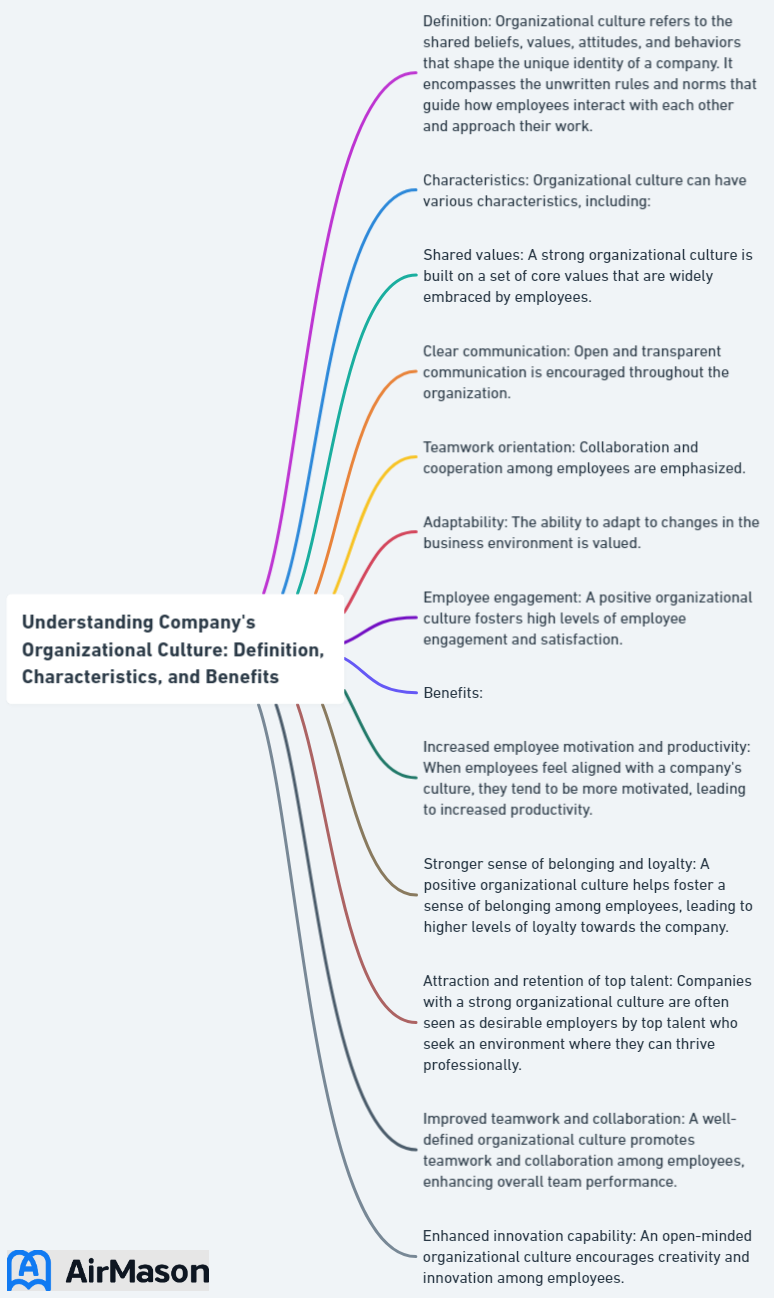
Have you ever wondered what makes some companies thrive while others struggle to survive? One of the critical factors that contribute to a company’s success is its company’s organizational culture. A strong and positive company’s organizational culture can propel a company to new heights, fostering employee engagement, innovation, and overall business success.
Key Takeaways
- Organizational culture is a set of values, beliefs and systems that define how employees behave in an organization.
- There are four main types of organizational culture (Clan, Adhocracy, Market and Hierarchy) each with their own advantages and disadvantages.
- Assessing current culture to identify areas for improvement as well as implementing changes can help create successful outcomes. Examples include Google & Apple’s focus on innovation & customer service respectively.
Defining Organizational Culture
Organizational culture refers to the set of values, beliefs, attitudes, systems and rules that cultivate and determine the way employees behave in a particular organization. These all characteristics of organizational culture are influential in one another thus creating an environment for the personnel within the organisation. Grasping this culture definition aids in comprehending its pivotal role in a company’s success. A robust organizational culture yields numerous benefits for the business, making culture important. It can affect everything from punctuality and tone, to contract terms and employee benefits. Employees tend to feel more supported and appreciated when the organization’s culture aligns with their values and beliefs, which in turn enhances performance and fosters a positive work environment.
In today’s fast-paced business environment, companies need to continually adapt and evolve to maintain their competitive edge. A robust organizational culture aids companies in weathering challenging times and emerging stronger – a vital factor for business success. But how can companies assess their current culture and take steps to improve it?

What is Organizational Culture?
Organizational culture, as defined by the Harvard Business Review, refers to the set of shared values, beliefs, attitudes, systems, and regulations that shape and guide employee behavior within an organization. These values and beliefs provide a foundation for the work environment, influencing how employees interact with each other and make decisions, ultimately forming the company’s culture.
A strong corporate culture can create a sense of identity and purpose within the organization, leading to increased employee engagement and productivity. Some notable examples of strong organizational cultures include:
- Google, which emphasizes innovation, collaboration, and customer service
- Apple, which fosters a culture of creativity and excellence
- Netflix, which promotes a culture of freedom and responsibility
These companies have also created cultures that are receptive to change and experimentation, allowing them to remain competitive in the ever-evolving tech landscape.
An Organization’s Culture
An organization’s culture refers to the collective values, beliefs, and behaviors that shape the way individuals interact within a workplace. It encompasses the shared norms that guide decision-making, communication, and problem-solving. A strong organizational culture fosters a sense of belonging and purpose among employees, driving them towards common goals. It sets the tone for how tasks are approached and challenges are met, ultimately influencing the overall performance and success of the company. Furthermore, an organization’s culture can significantly impact employee satisfaction, retention rates, and recruitment efforts. Therefore, it is essential for leaders to actively cultivate and nurture a positive and inclusive culture that aligns with the company’s mission and values.
Importance of Organizational Culture
A strong organizational culture is essential for employee retention, creativity, and overall business prosperity. Recognition has a beneficial impact on organizational culture, enhancing critical metrics such as employee engagement, retention, and productivity. Moreover, company values are the basis of organizational culture and should be incorporated into all facets of the business, such as HR policies, benefits programs, and out-of-office initiatives.
Human Resources plays a vital role in preserving organizational culture by attentively listening to employees and offering feedback to leadership. By sustaining a culture that is beneficial to productivity, performance, and engagement, a company can improve its chances of success in the competitive business world.
Four Main Types of Organizational Culture

The Competing Values Framework is a method of categorizing organizational cultures. It evaluates two contrasting values; flexibility and stability, as well as an internal or external focus. This framework identifies four main types of organizational culture:
- Clan Culture
- Adhocracy Culture
- Market Culture
- Hierarchy Culture
A comprehension of these types of organizational culture equips companies to evaluate their prevailing culture and chart out an optimal path for enhancement. Each type of culture has its strengths and weaknesses, so it is essential to find the right balance that aligns with a company’s values and desired outcomes.
Clan Culture
Clan Culture is characterized by a focus on collaboration, teamwork, and trust, and is often observed in startups and smaller companies. Cultivating a clan culture necessitates seeking employee input and fostering an environment of open communication. This collaborative approach fosters a sense of unity and solidarity among team members, resulting in higher levels of employee engagement and a greater potential for market expansion.
However, maintaining a familial corporate culture can become challenging as the company grows, and a horizontal leadership structure may appear disorganized and lacking guidance. It is crucial for companies with a clan culture to find the right balance between collaboration and structure to ensure continued success.
Adhocracy Culture
Adhocracy Culture is characterized by its promotion of innovation, risk-taking, and creativity, and is widely found in tech companies such as Google and Apple. Companies with adhocracy cultures often embrace change and experimentation, allowing them to stay ahead of the curve and remain competitive in a rapidly evolving market. This culture fosters a diverse and inclusive work environment, which is known to boost innovation and creativity.
However, there are also potential drawbacks to adhocracy cultures, such as new ventures not proving successful and even being detrimental to the business. Additionally, adhocracy cultures can create competition among employees as the demand for new ideas increases, potentially leading to job stress and burnout. It is essential for companies with adhocracy cultures to manage these potential risks carefully while fostering a culture of innovation and adaptability.
Market Culture
Market Culture is characterized by a focus on competition, profitability, and the achievement of results, and is commonly observed in industry-leading companies. In a market culture, companies prioritize achieving their organizational goals and maintaining a competitive edge in the market. Establishing a competitive reward and recognition system can be an effective measure to motivate employees, attract new customers, and ensure their satisfaction in an organization with a market culture.
On the other hand, a strong focus on competition and profitability can potentially lead to an overly aggressive work environment, which may negatively impact employees’ well-being and job satisfaction. Companies with a market culture need to find the right balance between competition and employee welfare to ensure long-term success.
Hierarchy Culture
Hierarchy Culture values structure, stability, and traditional corporate practices, and is common in established organizations. Companies with hierarchy cultures typically have well-defined processes and clear managerial structures, which contribute to improved risk management, steadiness, and operational effectiveness.
However, hierarchy cultures can also stifle creativity and innovation, making these organizations comparatively slow to adapt to changes in markets and industries. Additionally, the focus on the organization rather than the individual may not promote employee input and collaboration.
Companies with hierarchy cultures should strive to strike a balance between structure and flexibility to ensure they can adapt and thrive in a dynamic business landscape.
Good Work Culture: Fostering Productivity and Well-being
A good work culture is the cornerstone of a thriving and successful organization. It encompasses the values, beliefs, and practices that guide interactions and behavior within a workplace. In a setting with a strong emphasis on good work culture, employees feel valued, motivated, and empowered. This environment encourages open communication, collaboration, and a sense of belonging, ultimately leading to higher levels of productivity and job satisfaction. Moreover, a positive work culture not only attracts top talent but also retains existing employees, reducing turnover rates and ensuring the longevity of the organization. It goes beyond the physical workspace, permeating through the virtual realm, fostering a sense of community even in remote work setups.
Characteristics of Successful Organizational Cultures

Having explored the various types of organizational cultures, it becomes pivotal to understand the key traits that shape a successful organizational culture. These characteristics include having a well-defined vision and mission, cultivating shared values, and fostering effective communication.
By focusing on these elements, companies can create a strong organizational culture that drives employee engagement, innovation, and overall business success.
Clear Vision and Mission
Well-articulated vision and mission statements play a key role in steering a company’s culture and decision-making process. A powerful mission can have an effect on company culture by providing employees with a collective sense of purpose, while a vision statement outlines the ideal state or objective that the organization seeks to accomplish.
By having a clear vision and mission, companies can ensure that all employees are working towards the same goals and objectives, fostering a sense of unity and collaboration within the organization. These guiding statements can also be used to evaluate the success of the organization, helping companies to continually refine their strategies and adapt to changing market conditions.
Shared Values
Another integral component of a successful organizational culture is the shared core values among employees and leadership. These collective beliefs, principles, and attitudes serve as the foundation for employee behavior and actions when representing the organization. By fostering a sense of unity and solidarity among team members, shared values contribute to a cohesive and consistent organizational culture.
To maintain and promote shared company’s values within an organization, it is crucial to communicate these values effectively and ensure they are integrated into all aspects of the business. This includes:
- Incorporating values into HR policies
- Incorporating values into benefits programs
- Incorporating values into out-of-office initiatives
- Encouraging open communication and feedback from employees
Effective Communication
Fostering trust and collaboration within a company’s culture hinges on open and transparent communication. By encouraging open communication and providing opportunities for employees to share their thoughts and ideas, companies can create an environment where employees feel valued and heard. This, in turn, can lead to increased employee satisfaction, engagement, and overall business success.
Transparent communication also plays a critical role in promoting innovation and creative problem-solving within an organization. By creating a culture where employees feel comfortable sharing their ideas and opinions, companies can tap into a wealth of knowledge and expertise, driving innovation and continuous improvement.
Assessing and Developing Your Company’s Organizational Culture

Having discussed the significance of organizational culture and its key traits, it becomes imperative to evaluate and develop your company’s culture to align it with your values and desired outcomes. This process involves:
- Understanding your current culture
- Setting goals for improvement
- Implementing changes
- Monitoring progress to ensure success.
Assessing Your Current Culture
Identifying areas for improvement begins with understanding your current culture. To assess organizational culture, there are numerous methods available, such as:
- Employee surveys
- Observation of behavior and interactions
- Analysis of artifacts and symbols
- Review of company policies and practices
- Interviews and focus groups
By gaining an understanding of your company’s current culture, you can identify potential areas of misalignment with your values and desired outcomes. This information can serve as the foundation for developing a plan to improve your organizational culture and ensure it supports your company’s long-term success.
Setting Goals for Cultural Improvement
Upon assessing your current culture, it’s important to set clear goals for cultural improvement, reflective of your company’s values and desired outcomes. These goals should be specific, measurable, and achievable, providing a clear roadmap for your organization’s cultural development.
Implementing Changes and Monitoring Progress
After establishing your cultural improvement goals, the subsequent step involves implementing changes to improve company culture and bolster your organizational culture. This may involve modifying company policies, practices, or even organizational structure to better align with your desired culture. It is also crucial to communicate these changes effectively, ensuring all employees understand the rationale behind the changes and how they will impact their work.
Keeping track of progress is crucial to guarantee the success of your cultural improvement initiatives. This may involve:
- Tracking specific metrics
- Consistently reviewing progress
- Measuring the impact of changes on employee engagement, satisfaction, and overall business performance
By regularly evaluating your progress, you can make adjustments as needed to ensure your organizational culture continually supports your company’s success.
Creating a Positive Culture at Work
Creating a positive culture at work is essential for fostering productivity, employee satisfaction, and overall organizational success. It begins with clear communication and open channels for feedback. When employees feel heard and valued, they are more likely to engage actively in their roles. Encouraging teamwork and collaboration further strengthens this culture, as it promotes a sense of belonging and shared purpose among team members. Additionally, recognizing and celebrating achievements, both big and small, reinforces a positive atmosphere and motivates employees to strive for excellence. Providing opportunities for professional development and work-life balance also contribute significantly to a positive work culture, demonstrating a genuine investment in the well-being and growth of employees. By prioritizing these elements, organizations can cultivate an environment where employees thrive, ultimately driving the success of the company.
Examples of Strong Organizational Cultures

To underscore the role of organizational culture in propelling business success, we will review some examples of companies renowned for their strong organizational cultures. These companies have cultivated cultures that emphasize innovation, collaboration, and customer service, contributing to their success in their respective industries.
Google’s culture fosters creativity, innovation, and collaboration, which has contributed to its position as a tech industry leader. Google’s culture is employee-friendly and unconventional, providing benefits such as:
- Telecommuting
- Flextime
- Tuition reimbursement
- Free employee lunches
- On-site services including oil changes, car washes, massages, fitness classes, and a hairstylist.
The emphasis on innovation and collaboration at Google has enabled the company to stay at the forefront of the tech industry and continually develop new products and services that resonate with users worldwide. This strong organizational culture is a key factor in Google’s ongoing success.
Apple
Apple’s culture emphasizes design, innovation, and a customer-centric approach, leading to its success in the tech market. The company values expertise and functional specialization, prioritizing the hiring and nurturing of employees with deep expertise in their respective fields to enable a high level of innovation and problem-solving.
Apple’s focus on customer experience and commitment to quality has helped the company to establish a devoted customer base and a strong brand reputation. By fostering a culture that promotes design, innovation, and customer satisfaction, Apple has become one of the most successful companies in the tech industry.
Netflix
Netflix’s culture promotes freedom, responsibility, and adaptability, allowing it to thrive in the competitive entertainment industry. The company encourages a culture of innovation and exploration, enabling employees to explore new ideas and ways of achieving their work objectives.
By focusing on quality over quantity, Netflix has been able to create high-quality content that resonates with viewers and keeps them engaged. Additionally, Netflix’s culture of radical transparency and open communication enables the company to recognize areas for improvement and make necessary modifications to remain competitive in a rapidly evolving industry.
This strong organizational culture has been a key factor in Netflix’s success in the entertainment industry.
Summary
In conclusion, understanding and fostering a strong organizational culture is vital for driving employee engagement, innovation, and overall business success. By assessing your current culture, setting clear goals for improvement, and implementing changes, your company can create a culture that aligns with its values and desired outcomes. As the examples of Google, Apple, and Netflix demonstrate, a strong organizational culture can propel a company to new heights and enable it to thrive in a competitive business landscape.
Frequently Asked Questions
What are the 4 main types of organizational culture?
According to business professors Robert E. Quinn and Kim Cameron, there are four distinct types of organizational culture: clan culture, adhocracy culture, market culture, and hierarchy culture. These cultures can range from people-oriented and friendly, to process-oriented and structured, to dynamic and entrepreneurial, and results-oriented and competitive.
What is an example of organizational culture?
Zappos and Adobe are great examples of organizational culture, with Zappos hiring for culture first and providing a culture camp training event, while Adobe supports employee well-being through initiatives like subsidized gym memberships and tuition reimbursement.
What is an example of a company with good organizational culture?
Google is a prime example of an organization with great culture, offering perks such as free meals, employee vacations and parties, cash bonuses, open speeches by high-level executives, employee recognition, gyms, and pet-friendly policies.
What are the key characteristics of a successful organizational culture?
A successful organizational culture is characterized by a well-defined vision and mission, shared values, and effective communication.
How can a company assess and improve its organizational culture?
Companies can assess their current culture, set goals for improvement, implement changes, and monitor progress to ensure successful improvements to their organizational culture.